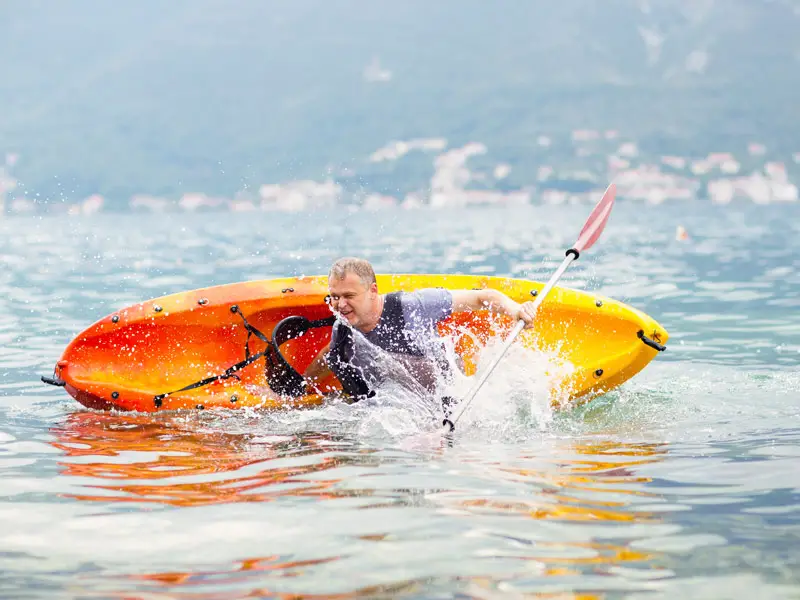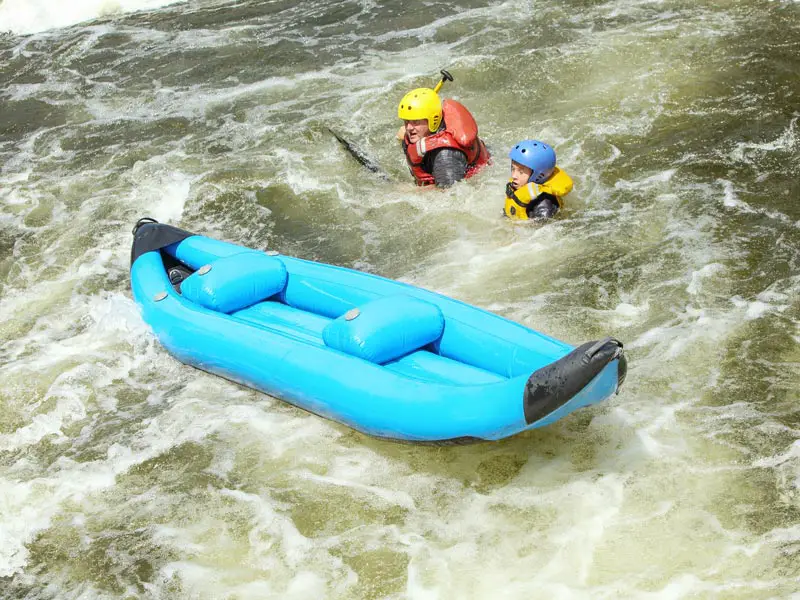Getting out on the water for the first time can be a little daunting, especially if you’ve heard horror stories of people capsizing and being unable to get their kayak righted without help. Nobody likes the thought of being trapped underwater, but the best remedy for fear is understanding the thing you’re afraid of, and that’s exactly what I hope to give you here. So, do canoes tip over easily, and are canoes stable?
To start with let’s just put it out there that canoes are relatively stable and not especially prone to tipping. Could you tip a canoe relatively easily if you were trying? Absolutely. But you’re not going to find yourself upside down and underwater as the result of a little bit of turbulent flow, or your partner shifting their weight a little. Indeed, if you were to ask several canoe enthusiasts, you would likely find that some of them have never accidentally capsized a canoe in their life. Not once!
At least, that’s what they claim.
As long as everyone in the canoe is behaving sensibly, adhering to good practices, and you keep a relatively stable center (don’t lean too far to one side), there is no reason to worry about your canoe capsizing.
Is it a Canoe?
The first thing to clear up, and it’s something that most beginners in the world of canoeing struggle with, is that canoes and kayaks are technically not the same thing. I say technically because the difference between the two has more to do with the persons using it than it does the canoe itself, but at a fundamental level, we can distinguish the two like this;
A kayak is propelled by double-bladed paddle with the which the paddled propels the kayak forward with alternate strokes on either side. In a canoe, the paddler uses a singled-bladed paddle to move through the water, switching sides as needed.
While kayaks and canoes can both be arranged in different ways, I thought it important we set this out because when people think of those horror stories I mentioned earlier—the ones where the canoe goes over and the person inside struggles to get out—that’s a kayak, not a canoe.
There are two main types of canoe to consider here; you have your larger, more recreational canoes, that look like a thin rowing boat and often have benches, and you have competitive canoes, which look very similar to kayaks but the paddler kneels, rather than sits. In both types of canoe, the paddler is in no way secured in place. In the event of capsizing, it should be very easy for them to get out of the canoe and to safety.
With kayaks, the paddlers legs will often be inside the craft. In some cases the kayak will have a skirt to keep the paddler drier and warmer than they would otherwise have been. Now, the panic that beginners often feel towards kayaks because of the threat of capsizing is also overblown most of the time, but I wanted to make it clear that, for canoes, it’s even less so.
How to Avoid Tipping a Canoe
So, back to the topic at hand; are canoes stable? Let’s answer this by looking at how you ensure that your canoe stays facing the right way up?
Center of Gravity
Have you ever noticed that high-end sports cars and racing cars are often very low in profile, and don’t give much clearance between the skirt of the car and the ground beneath? This is to do with a concept called center of gravity.
Your center of gravity is the point at which your mass is concentrated, and it is a crucial aspect in stability. The center of gravity for our high-end sports cars is extremely low, and this allows them to take corners at high speed. Taller vehicles like trucks and SUVs cant take corners anywhere as fast as a sports car due to a higher center of gravity.
The premise is similar for canoeing. Any time you stand up, lean to the side, or stick your arms out, you shift your center of gravity to the side, and that makes the canoe tilt. Here’s the tricky part. If you shift your center of gravity far enough to the side that it is no longer over the canoe, it will want to fall downwards. Now your center of gravity is not just off to the side, tilting the boat, but it is also pulling straight down, and that’s when the canoe tips.
For this reason, you should avoid doing things like reached out to push branches aside or attempted to fish something out of the water that is a little too far from the canoe. Once the canoe starts to tip, it is very difficult to stop it, and attempts to counter the tipping motion often end in an over-correction, with the canoe tipping back the other way.
This is also why it helps to keep low when going through turbulent water. The higher you are sitting up, the higher your center of gravity, and greater the tilting force will be if you move to the side.

Stick to the Middle
Far more canoes capsize during the entering and exiting stage of things than they do while actually being paddled around, so learning how to get into a canoe can go a long way to keeping it upright. When getting in or out of your canoe, be sure to keep to the middle. Stepping on the sides of the canoe will cause it to tip, and if you’re not expecting it, you’ll almost certainly be caught off-balance and end up in the water.
Don’t Overload Your Canoe
This one may seem a little counterintuitive, since putting more weight in your canoe (we’re assuming gear, not people) will effectively lower the canoes center of gravity, making it harder to tip. However, while this is true, it is also true that the additional weight makes the canoe sit lower in the water. These are not big, deep boats to begin with, and you are already sailing close to the water as it is. Overloading your canoe will put you in a situation where much less of a tilt or even a small wave is needed for the rim of the boat to dip under the water.
You may not capsize from this, but an already overloaded boat taking on water is a recipe for a wet afternoon!
Learn to Brace
Sometimes you do just lose your balance, however this doesn’t necessarily mean you are going for a swim. You can use your paddle with the blade flat against the water to brace yourself long enough to regain balance.
Practice Practice Practice
It’s a bit cliched, but it’s cliched for a reason; practice makes perfect. No amount of describing how to keep yourself safe in a canoe will compare to the experience gained from actually doing it.
Now, I’m not advocating jumping in at the deep end—figuratively or literally—definitely get your canoe legs in a safe environment. But build up that confidence by actually doing the thing, rather than just reading about it. The more you get out on the water, the more the motions and behaviors you need to master to keep yourself upright will become second nature. Before you know it, you’ll be paddling around without a second thought to whether or not you might capsize.
Observe Proper Safety Precautions
Canoeing is a relatively safe activity, although all water sports carry some inherent risk. Before you set out, make sure you know how to stay safe canoeing.
It probably shouldn’t need to be said, but I’m going to say it anyway; life vests should be considered an absolute necessity, no matter how good a swimmer you are. You will rarely find somebody paddling a canoe without a life vest, even if they are the most seasoned of water goers, and that is because there is more than just your swimming ability at play here.
Firstly, canoeing often takes place in cold water, and being suddenly plunged into cold water can cause shortness of breath and even blackouts, something known as cold water shock.
Coming around from a brief stint of unconsciousness to find yourself slowly sinking to the bottom of a river is not an ideal way to wake up. There is also the matter of the canoe itself. While the chances are a capsizing canoe will result in nothing more than some very wet people, any time you flip a big solid object with people in it over, there is a chance someone could get a knock on the head, which can also result in unconsciousness.
For people taking their canoes out on more adventurous waters, life vests could be the difference between floating to safety and getting dragged under by the current. In short; wear your life vest!
What To Do If Your Canoe Does Capsize?
If you are only ever paddling in sheltered waters, it is possible that you may never capsize your canoe. However, you do need to have in place a plan in the event of the unexpected happening.
If you capsize very close to shore on still or slow-moving water, you may find it easiest to swim and drag your canoe the very short distance to shallow water so you can stand up and easily flip your canoe.
If you are further out when you capsize then you have only two options. That is to either attempt a self-rescue or to abandon your canoe and swim to shore. What you choose to do will depend on the circumstances and conditions of the water you are paddling in at the time. It is worth learning and practicing how to flip your canoe back over and to self-rescue as it may save you from having to abandon your canoe.

Final Thoughts: Are Canoes Stable?
I’d be lying if I said canoes weren’t a little unstable from time to time. In truth, all water-going craft have the same instabilities, it is just that the long, narrow design of a canoe makes that instability so much more obvious. One way people have tried to combat this is by creating outrigger canoes.
That being said, the reputation of the humble canoe as something that will flip over if you so much as look at is undeserved. With the proper care and attention, you will never need to worry about your canoe capsizing. And with enough practice, you probably won’t even think about it.
